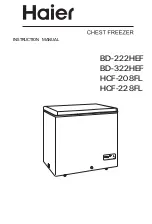
22
Storing food
Storing food
Storing food
Storing food
The
freezer allows you to store frozen food at a temperature of -18°C or below (from a medium
temperature control setting) for several months, to produce ice cubes and to freeze fresh good. Due to
external influences such as room temperature, placements, frequency of opening the door and the
amount of food the temperature in the freezer can be influenced.
Freezing
Freezing
Freezing
Freezing
•
24 hours before freezing we recommend turning the temperature control to the highest power level
and to keep this setting even after freezing for a few hours. The appliance is not compromised if
the setting will not revert to a medium operating temperature after the freezing process, but for
economic reasons you should possibly avoid it.
•
Fresh food should be frozen as fast as possible to the core. Therefore during freezing operation,
the temperature of fresh food should be lowered as fast as possible in order to keep formation of
ice crystals as little as possible and not to damage the food structure.
•
Frozen food should be kept in contact with the bottom of the compartment.
•
Keep a space between the individual items, so that the cold air can circulate.
Storing frozen food
Storing frozen food
Storing frozen food
Storing frozen food
•
Packed frozen merchandise should be stored in a 4-star-freezer compartment in accordance with
the manufacturer’s data. Make sure the food items do not defrost after purchase and to store them
as fast as possible in the freezer.
•
It is possible to store food for longer periods of time, up to three months. This period might vary, so
observe the storage information on the packaging of the merchandise.
NOTE
NOTE
NOTE
NOTE::::
Make sure that the temperature in the freezer does not rise above -18°C. Moreover the appliance
should be defrosted regularly. A thick layer of ice on the wall deteriorates the cooling effect and the
power consumption increases.
Safe
Safe
Safe
Safety precautions
ty precautions
ty precautions
ty precautions
•
Do not store bottles or cans in the freezer. These can break when the contents freeze – or even
explode, if they contain carbonated drinks.
•
Once products have been defrosted halfway or completely, they should be consumed as soon as
possible and should not be frozen again, except they have been processed to a ready meal.
•
Do not open the door in case of power failure. If the failure does not take longer than 15 hours, the
food will not be affected.
•
Do not eat food that is still frozen. Do not allow children to eat ice cream directly from the freezer.
The cold can cause injuries in the oral cavity.
•
Touching metal parts inside the appliance can cause symptoms similar to burns if the skin is very
sensitive.
•
Do not touch frozen food with moist or wet hands; they could freeze to the items.







































